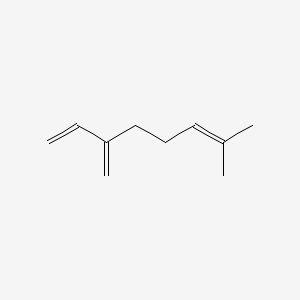| Authors | Title | Published | Journal | PubMed Link |
|---|---|---|---|---|
| Yin J et al. | Functional analysis of general odorant binding protein 2 from the meadow moth, Loxostege sticticalis L. (Lepidoptera: Pyralidae). | 2012 | PLoS ONE | pmid:22479417 |
| Pareja M et al. | Herbivory by a Phloem-feeding insect inhibits floral volatile production. | 2012 | PLoS ONE | pmid:22384116 |
| Hyldgaard M et al. | Essential oils in food preservation: mode of action, synergies, and interactions with food matrix components. | 2012 | Front Microbiol | pmid:22291693 |
| Padalia RC et al. | Chemical composition of leaf and root essential oils of Boenninghausenia albiflora Reichb. from northern India. | 2012 | Nat. Prod. Res. | pmid:22111591 |
| Yvon Y et al. | Relation between chemical composition or antioxidant activity and antihypertensive activity for six essential oils. | 2012 | J. Food Sci. | pmid:22860587 |
| Bairwa R et al. | Trachyspermum ammi. | 2012 | Pharmacogn Rev | pmid:22654405 |
| Wang YW et al. | Chemical composition and antimicrobial activity of the essential oil of kumquat (Fortunella crassifolia Swingle) peel. | 2012 | Int J Mol Sci | pmid:22489157 |
| Zheljazkov VD et al. | Distillation time alters essential oil yield, composition, and antioxidant activity of male Juniperus scopulorum trees. | 2012 | J Oleo Sci | pmid:23018851 |
| Leung JC et al. | Direct, redox-neutral prenylation and geranylation of secondary carbinol C-H bonds: C4-regioselectivity in ruthenium-catalyzed C-C couplings of dienes to α-hydroxy esters. | 2012 | J. Am. Chem. Soc. | pmid:22985393 |
| Singh V et al. | Direct analysis in real time by mass spectrometric technique for determining the variation in metabolite profiles of Cinnamomum tamala Nees and Eberm genotypes. | 2012 | ScientificWorldJournal | pmid:22701361 |
| Fernandes C et al. | Investigation of the mechanisms underlying the gastroprotective effect of cymbopogon citratus essential oil. | 2012 | J Young Pharm | pmid:22523457 |
| Amiri H | Essential oils composition and antioxidant properties of three thymus species. | 2012 | Evid Based Complement Alternat Med | pmid:21876714 |
| Kim E and Park IK | Fumigant antifungal activity of Myrtaceae essential oils and constituents from Leptospermum petersonii against three Aspergillus species. | 2012 | Molecules | pmid:22945026 |
| Messaoud C et al. | Chemical composition and antioxidant activities of essential oils and methanol extracts of three wild Lavandula L. species. | 2012 | Nat. Prod. Res. | pmid:22117129 |
| Lüddeke F and Harder J | Enantiospecific (S)-(+)-linalool formation from beta-myrcene by linalool dehydratase-isomerase. | 2011 Jul-Aug | Z. Naturforsch., C, J. Biosci. | pmid:21950166 |
| Aiemsaard J et al. | The effect of lemongrass oil and its major components on clinical isolate mastitis pathogens and their mechanisms of action on Staphylococcus aureus DMST 4745. | 2011 | Res. Vet. Sci. | pmid:21316719 |
| Caballero-Gallardo K et al. | Repellent activity of essential oils and some of their individual constituents against Tribolium castaneum herbst. | 2011 | J. Agric. Food Chem. | pmid:21291237 |
| Salleh WM et al. | Chemical compositions, antioxidant and antimicrobial activities of essential oils of Piper caninum Blume. | 2011 | Int J Mol Sci | pmid:22174627 |
| He P et al. | Distinct expression profiles and different functions of odorant binding proteins in Nilaparvata lugens Stål. | 2011 | PLoS ONE | pmid:22174925 |
| Abbasipour H et al. | Fumigant toxicity and oviposition deterrency of the essential oil from cardamom, Elettaria cardamomum, against three stored–product insects. | 2011 | J. Insect Sci. | pmid:22242564 |
Myrcene
Myrcene is a lipid of Prenol Lipids (PR) class. Myrcene is associated with abnormalities such as Hypomenorrhea, abnormal fragmented structure, Nephrosis, Renal tubular disorder and Kidney Diseases. The involved functions are known as Anabolism, Gene Expression, Protein Biosynthesis, Mutation and Selection, Genetic. Myrcene often locates in Plastids, Proboscis, Body tissue, Clone and soluble. The associated genes with Myrcene are TTPA gene, monoterpene synthase, Genome, 4S-limonene synthase and Homologous Gene. The related lipids are Pinene, Octanols, Membrane Lipids and Fatty Acids, Unsaturated.
Cross Reference
Introduction
To understand associated biological information of Myrcene, we collected biological information of abnormalities, associated pathways, cellular/molecular locations, biological functions, related genes/proteins, lipids and common seen animal/experimental models with organized paragraphs from literatures.
What diseases are associated with Myrcene?
Myrcene is suspected in Nephrosis, Kidney Diseases, Dehydration, Hypomenorrhea, Renal tubular disorder and other diseases in descending order of the highest number of associated sentences.
Related references are mostly published in these journals:
| Disease | Cross reference | Weighted score | Related literature |
|---|
No disease MeSH terms mapped to the current reference collection.
PubChem Associated disorders and diseases
What pathways are associated with Myrcene
There are no associated biomedical information in the current reference collection.
PubChem Biomolecular Interactions and Pathways
Link to PubChem Biomolecular Interactions and PathwaysWhat cellular locations are associated with Myrcene?
Visualization in cellular structure
Associated locations are in red color. Not associated locations are in black.
Related references are published most in these journals:
| Location | Cross reference | Weighted score | Related literatures |
|---|
What functions are associated with Myrcene?
Related references are published most in these journals:
| Function | Cross reference | Weighted score | Related literatures |
|---|
What lipids are associated with Myrcene?
Related references are published most in these journals:
| Lipid concept | Cross reference | Weighted score | Related literatures |
|---|
What genes are associated with Myrcene?
Related references are published most in these journals:
| Gene | Cross reference | Weighted score | Related literatures |
|---|
What common seen animal models are associated with Myrcene?
There are no associated biomedical information in the current reference collection.
